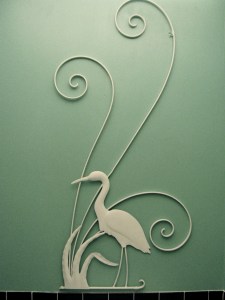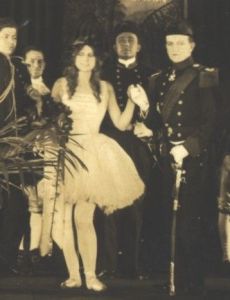 This stunning 1940s dressing gown
This stunning 1940s dressing gown in silver grey satin with raspberry embellishments, serves not only as a reminder of just how lovely vintage lingerie can be, but also to properly store your clothing because this beautiful old dressing gown has color transfer marks.
in silver grey satin with raspberry embellishments, serves not only as a reminder of just how lovely vintage lingerie can be, but also to properly store your clothing because this beautiful old dressing gown has color transfer marks.
Sometimes these spots are not permanent, but remember to use archival tissue when packing away your collectible fashions, your own wedding dress, etc., and you’re more likely to avoid them to begin with.
In fact, as a general rule, any valuable textile not in continual (or rotational) use at least every 2 months, should be properly stored and put away to preserve and protect them from damages.
Here are some tips for properly packing away clothing, fine vintage linens, and other textiles:
1. Begin with clean, dry clothing. Unless instructed to do so by a textiles archivist professional or clothing conservator, do not dry clean, starch or otherwise treat the clothing; just prepare the piece by gently, but thoroughly, cleaning it. (Any fabric items to be packed away must be completely dry before you begin.)
2. Look over the textiles for any damages. If you discover insects, mold or mildew, isolate the item in a sealed container immediately so that these live things (yes, mold and mildew are as alive as insects!) do not spread to other textiles.
3. Clean hands only. As oils and dirt, etc., can be transferred from your hands, causing future damage or deterioration, it’s best to wear archival-quality gloves. If you do not have such gloves, begin with clean hands — and wash & dry them as needed to ensure they remain as clean as possible.
4. Textiles and clothing to be preserved should be stored in special archival boxes only.
Never store valuable textiles in plastic containers (or even ‘protectively’ use plastic wrap) for two reasons: One, plastic deteriorates over time, creating poly vinyl chloride gases which may cause fabrics to yellow; and two, plastic does not breathe, which, with temperature and humidity changes, may encourage the growth of mold and mildew.
Longterm storage of linens and textiles in a cedar or wood chest is not recommended. Wood fibers contain acid which, when in direct contact with textiles, may cause deterioration and decay of the material, often resulting in dark yellow or brownish stains. While these stains may be removed (via the use of bleaching agent, for example), the fabric is weakened by both the exposure to the wood acid and to the bleaching or cleaning agent.
5. For the best results fine vintage linens and textiles should be carefully stored in acid free tissues.
There are two basic types of acid-free tissues: Buffered and Unbuffered.
Buffered tissues are ideal for wrapping and padding cottons or linens, this acid-free paper has an alkaline buffer or Alkaline Reserve (commonly a calcium or magnesium salt) to help prevent acid migration. (Buffered tissue is a little stiffer and more opaque than the unbuffered tissue.) However, this alkaline buffer can be damaging to silk or wool objects. So when in doubt, or for general textile preservation purposes, go with unbuffered, or pH neutral acid-free tissues.
6. Acid-free tissues are used to prevent folds and abrasions between textile surfaces. This is done by stuffing and interleaving (placing or layering of barrier sheets of tissues).
Lightly stuff any sleeves, bodices, etc. with archival tissue, giving clothing a three-dimensional shape and so keeping any fabric from laying or rubbing against itself.
Multiple layers of tissue are sandwiched between the front and back layers of garments; apply generous layers of tissue to protect fabric from metalwork such as zippers, hooks & eyes, etc., as well as decoartive work such as beading, to avoid rubbing and imprints.
7. Prepare the box. Before placing the clothing in the box, line the box with sheets of the acid free archival tissue paper and loosely cover the item, so that it is fully wrapped in tissue (rather like hiding a sweater in a gift box).
If the garment is so large that you must fold it to fit in the box, ‘stuff’ the fold with crumpled archival tissue paper (so that the fold doesn’t lie perfectly flat or make a sharp crease) and layer the garment with other tissues (so that the fabric does not fold back upon itself).
8. Clothing items should be individually stored in special garment-sized archival boxes; but you may pack away several smaller items in a box, as long as you don’t overload the box &/or “smash” the clothing or tissue.
9. Where to store the box/boxes? Sunlight is damaging for all textiles, so dark is a given. But avoid basements, attics, and other locations with extreme temperatures &/or humidity as well as great fluctuations in temperature and humidity. Simply put, the best place for storing the properly boxed textiles is where the living is most comfortable — on levels of your home that you live on. Closets in an interior wall, under your bed, etc. are typically the best options.
10. Ideally, these storage boxes are opened at least once a year, the textiles and garments unfolded, larger pieces such as quilts are aired out (inside, away from direct sunlight) and then refolded differently before being stored again.
If this doesn’t exactly appeal to you, remember why you are doing it! And why not consider making this preservation anniversary a celebration or story-telling event with family and friends? (Just save the punch and snacks for once all the textiles are safely in their boxes again!)












































































